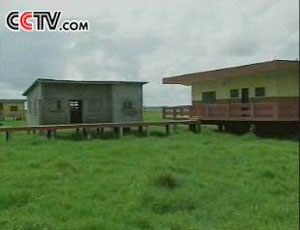Source: CCTV.com
10-25-2006 17:33
 |
Mt.Kilimanjaro is the highest mountain in Africa. In Swahili, a language of eastern African, 'Kilimanjaro' means 'a bright mountain'. With a streaming five-red-star flag on its summit, the 'Into Africa' T.V. production unit will bring a satisfactory close to its large-scale filming mission.
At the end of their three-month trip, the three teams covering the three separate routes have entered the last stage. The Kilimanjaro is now appearing far away on horizon.
The west-route team
The west-route team has been deep into the Congo (Zaire). Assisted by the Chinese Embassy and Chinese peace-keeping troops, the team pulled safe and sound out of the war-trodden ares and into Rwanda, a country well-known for being mountainous.
 |
Rwanda is a small inland country in central Africa with a population of just over 8 million.
Kigali, the capital of Rwanda
Rwanda has many mountains and rivers the most famous of which perhaps being the White Nile River, a source of the Nile, which originates here. However, when entering this country, people have on their mind, not so much its scenic views, but the massacre of 1994 which stunned the world.
At that time plane was shot down by earth to air rocket above Kigali Airport. The date was April 6, 1994. The President of Rwanda, Habyarimana, and the President of Burundi were on board, having just attended an area safety conference in Dar es Salaam. This terrorist act triggered what has become known as the Rwanda Genocide.
The Hutu and Tutsi are the two chief ethnic groups in Rwanda. In their long history they had no hatred against each other, instead living peacefully together, intermarrying, using the same language and leading a similar lifestyle.
 |
The graveyard of those killed in the genocide
The root of the tragedy originates in a time when the country was a Belgian colony. Ibn order to rule more conveniently, the colonialists often pittted one ethnic group against another and so in 1962, when the Hutu people took power, they began a series of discriminative policies against the Tutsi. Conflicts resulting in bloodshed frequently occurred between the two groups.
In 1994 it was rumored that Tutsi anti-government troops were behind the plane crash that resulted in the death of the Hutu President and, the day after the spreading of this message, a massacre against against the Tutsi took place. This single massacre quickly and ultimately developed into genocide between the two groups. Within just 100 days, a million lives had been claimed.
Editor:Wang Ping
